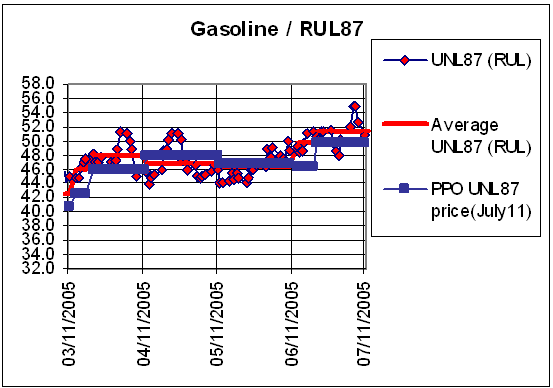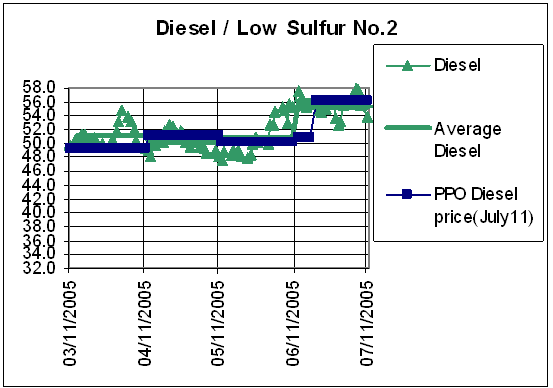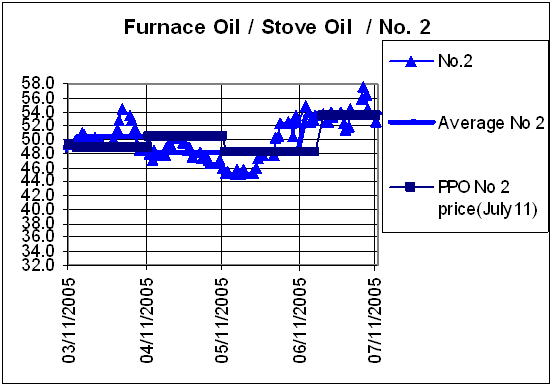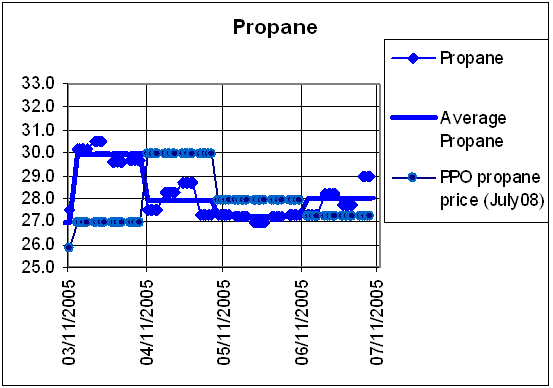NLIS 1
July 15, 2005
(Government Services)
The following is being distributed
at the request of the Petroleum Pricing Office:
Petroleum Pricing
Office sets maximum fuel prices July 15
Effective 12:01 a.m., Friday, July
15, 2005, the Public Utilities Board�s Petroleum Pricing Office (PPO)
will set maximum fuel prices for Newfoundland and Labrador (NL) as
per its regularly scheduled adjustment.
The maximum price for all types of gasoline will increase by 1.6/1.7
cents per litre (cpl), while diesel prices will decrease by 0.9/1.0
cpl (depending on the HST rounding effect for a particular pricing
zone). In the home heating fuels category, the maximum price of
furnace/stove oil will rise by 0.29 cpl, and residential propane by
0.8 cpl.
David Toms, PPO director (acting), said the commodities market has
experienced a large amount of pricing movement in recent weeks
ranging from brief periods of declines to continuing record high
trading prices on NYMEX (New York Mercantile Exchange) for refined
fuels, including gasoline and distillate fuels (furnace/stove oil
and diesel).
Recent events have had a significant impact on the prices for these
petroleum products. Included are weather, as tropical storms and a
hurricane hit the Gulf of Mexico where major oil production occurs;
fears over fuel supply and availability later this year; as well as
geopolitical events, such as the recent terrorism attacks in London,
England. All have combined to make the market increasingly sensitive
to any event that might impact on suppliers� ability to cope with
increasing demands.
�During this pricing period, circumstances have evolved where record
highs have been set in the commodities� markets for refined
petroleum products, and this has led to record retail prices for
these products throughout North America,� said Mr. Toms. �The
objective of regulation is to balance pricing pressures and set
prices upward or downward based on the average of prices over a
specific period. Regulation enables consumers in Newfoundland and
Labrador to avoid the volatility of pricing behaviours being
experienced in other Canadian markets and provides a measure of
stability between pricing adjustments.�
INFLUENTIAL FACTORS
Factors that have played a major role in influencing market pricing
data during this period were:
- Fuel prices reached initial
records on concerns Iran�s new president may limit foreign
investment in the nation�s oil industry. Iran is OPEC�s
(Organization of Petroleum Exporting Countries) second-biggest
producer.
- Weather: several major storms in
the Gulf of Mexico pushed the market to new record levels, as
many production platforms and refineries were shut. Fear of
damage to pipelines and other infrastructure played a major role
in escalating market prices and concerns about any prolonged
disruptions to supplies to the U.S. (the world�s largest
consumer). Prices receded when Hurricane Dennis missed most oil
and gas rigs, but Tropical Storm Emily is renewing fears as it
heads for the Gulf. Weather forecasters note that this is the
beginning of what�s expected to be an active storm season.
- Terrorism: the public
transportation in London, England was attacked by bombs, and
though market prices increased immediately, they subsided for a
brief period on reports that this could mark the beginning of an
economic slowdown, just like what occurred after the September
11, 2001 terrorist attacks in the U.S. This low was short-lived,
as fears of future supply were regenerated making it the largest
one-day price swing in 14 years.
- Distillate fuel (furnace/stove
oil and diesel) prices have remained elevated since the peak
home heating season passed mainly because of an increased demand
for diesel. As well, concerns continue about refiners� ability
to rebuild stockpiles (currently in the upper end of the
seasonal range) in advance of the winter season.
- Oil and gasoline stocks are
still reported to be in a healthy position, as OPEC is currently
producing at its highest rate in 25 years.
- Traders also believe refiners
(operating at 98 per cent during the week ended July 8 � the
highest since 1999, according to Bloomberg News) lack the spare
capacity to meet demands that are going to be placed on fuels
later in the year.
- Increased demand for fuel came
about because of the Canada Day and Independence Day long
weekends, as travel was expected to rise along with consumption
levels.
- The global economy is still
expected to grow, and continues to place upward pressure on fuel
prices as consumption rates increase.
- Concerns about available fuel
supplies eased slightly early in the period when oil workers and
employers in Nigeria (the world�s third largest oil exporter
after Saudi Arabia and Russia) averted a strike that could have
halted as much as half of the nation�s oil and gas production.
The threat of another strike involving oil workers in Norway
also heightened concerns about supply disruptions.
BACKGROUNDER
The PUB adjusts fuel prices on the
15th of each month using the average daily prices for finished
petroleum products as listed on NYMEX (New York Mercantile
Exchange). Illustrated in the following four graphs are the
market-price performances of the products regulated by the PPO for
recent regularly scheduled pricing periods up to July 11, 2005:




1.
Automotive Fuels � Maximum Retail Pump
Prices � Effective July 15, 2005
2. Heating Fuels-Maximum Tank Wagon
(or ** Tank Farm) Prices � July 15, 2005
3. Heating Fuels � Residential Propane
� Maximum Tank Wagon Prices � Effective July 15, 2005.
Media contact: Michelle Hicks, Communications. Tel: 1-866-489-8800
or (709) 489-8837.
2005 07 15
10:35 a.m.
|








